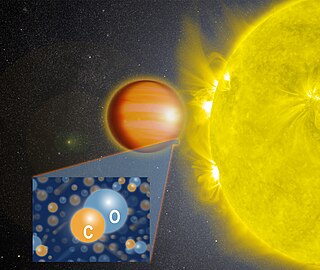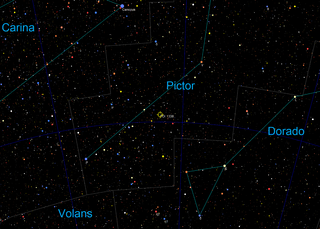Related Research Articles

WASP-4b is an exoplanet, specifically a hot Jupiter, approximately 891 light-years away in the constellation of Phoenix.

WASP-12b is a hot Jupiter orbiting the star WASP-12, discovered on April 1, 2008, by the SuperWASP planetary transit survey. The planet takes only a little over one Earth day to orbit its star, in contrast to about 365.25 days for the Earth to orbit the Sun. Its distance from the star is only the Earth's distance from the Sun, with an eccentricity the same as Jupiter's. Consequently, it has one of the lowest densities for exoplanets. On December 3, 2013, scientists working with the Hubble Space Telescope (HST) reported detecting water in the atmosphere of the exoplanet. In July 2014, NASA announced finding very dry atmospheres on three exoplanets orbiting sun-like stars.
HD 118203 b, formally named Staburags, is a jovian planet that takes only 6.13 days or 147 hours to orbit the parent star HD 118203 at a distance of 0.07 astronomical units. The exact mass was not known since inclination was not known until TESS detected the planet. This hot Jupiter is unusual since it has relatively high eccentricity of 0.31.

WASP-18b is an exoplanet that is notable for having an orbital period of less than one day. It has a mass equal to 10 Jupiter masses, just below the boundary line between planets and brown dwarfs. Due to tidal deceleration, it is expected to spiral toward and eventually merge with its host star, WASP-18, in less than a million years. The planet is approximately 3.1 million km from its star, which is about 400 light-years from Earth. A team led by Coel Hellier, a professor of astrophysics at Keele University in England, discovered the exoplanet in 2009.

TOI-1338 is a binary star system located in the constellation Pictor, about 1,320 light-years from Earth. It is orbited by two known circumbinary planets, TOI-1338 b, discovered by the Transiting Exoplanet Survey Satellite (TESS) and BEBOP-1c, discovered by the Binaries Escorted By Orbiting Planets project.

HD 191939 is a single yellow (G-type) main-sequence star, located approximately 174 light-years away in the constellation of Draco, taking its primary name from its Henry Draper Catalogue designation.
Qatar-1 is an orange main sequence star in the constellation of Draco.
WASP-72 is the primary of a binary star system. It is an F7 class dwarf star, with an internal structure just on the verge of the Kraft break. It is orbited by a planet WASP-72b. The age of WASP-72 is younger than the Sun at 3.55±0.82 billion years.
HD 108236 is a G-type main-sequence star. Its surface temperature is 5660±61 K. HD 108236 is severely depleted in heavy elements compared to the Sun, with a metallicity Fe/H index of −0.28±0.04, and is probably older than the Sun at an age of 6.7+3.3
−3.4 billion years.
KELT-1 is a F-type main-sequence star. Its surface temperature is 6518±50 K. It is similar to the Sun in its concentration of heavy elements, with a metallicity Fe/H index of 0.008±0.073, but is much younger at an age of 1.75±0.25 billion years. The star is rotating very rapidly.
TOI-640 b is an exoplanet that was suspected since 2019, discovery been confirmed by TESS team in January 2021. It is located 1115 light years away from Earth, orbiting primary F-class star in the binary star system with red dwarf and has an orbital period of 5 days.

L 98-59 b is an exoplanet having a size between that of the Earth and Mars and a mass only half that of Venus. It orbits L 98-59, a red dwarf 35 light-years away in the constellation Volans. There are at least 3 other planets in the system: L 98-59 c, d, e, and the unconfirmed L 98-59 f. Its discovery was announced on 27 June 2019 on the NASA website. It was the smallest planet discovered by TESS until the discovery of LHS 1678b, and was the lowest-mass planet whose mass has been measured using radial velocities until Proxima Centauri d was found in 2022.
References
- ↑ Gan, Tianjun; Shporer, Avi; Livingston, John H.; Collins, Karen A.; Mao, Shude; Trani, Alessandro A.; Gandolfi, Davide; Hirano, Teruyuki; Luque, Rafael; Stassun, Keivan G.; Ziegler, Carl; Howell, Steve B.; Hellier, Coel; Irwin, Jonathan M.; Winters, Jennifer G.; Anderson, David R.; Briceño, César; Law, Nicholas; Mann, Andrew W.; Bonfils, Xavier; Astudillo-Defru, Nicola; Jensen, Eric L. N.; Anglada-Escudé, Guillem; Ricker, George R.; Vanderspek, Roland; Latham, David W.; Seager, Sara; Winn, Joshua N.; Jenkins, Jon M.; Furesz, Gabor; Guerrero, Natalia M.; Quintana, Elisa; Twicken, Joseph D.; Caldwell, Douglas A.; Tenenbaum, Peter; Huang, Chelsea X.; Rowden, Pamela; Rojas-Ayala, Bárbara (18 March 2020). "LHS 1815b: The First Thick-disk Planet Detected by TESS". The Astronomical Journal. 159 (4): 160. arXiv: 2003.04525 . Bibcode:2020AJ....159..160G. doi: 10.3847/1538-3881/ab775a . hdl: 1721.1/125260 . ISSN 1538-3881. S2CID 212644667.
- ↑ Martin, Pierre-Yves (1995). "Planet LHS 1815 b". exoplanet.eu. Retrieved 2024-01-05.
- 1 2 Gan, Tianjun; Shporer, Avi; Livingston, John H.; Collins, Karen A.; Mao, Shude; Trani, Alessandro A.; Gandolfi, Davide; Hirano, Teruyuki; Luque, Rafael; Stassun, Keivan G.; Ziegler, Carl; Howell, Steve B.; Hellier, Coel; Irwin, Jonathan M.; Winters, Jennifer G. (2020-04-01). "LHS 1815b: The First Thick-disk Planet Detected by TESS". The Astronomical Journal. 159: 160. doi:10.3847/1538-3881/ab775a. ISSN 0004-6256.
{{cite journal}}: CS1 maint: unflagged free DOI (link)